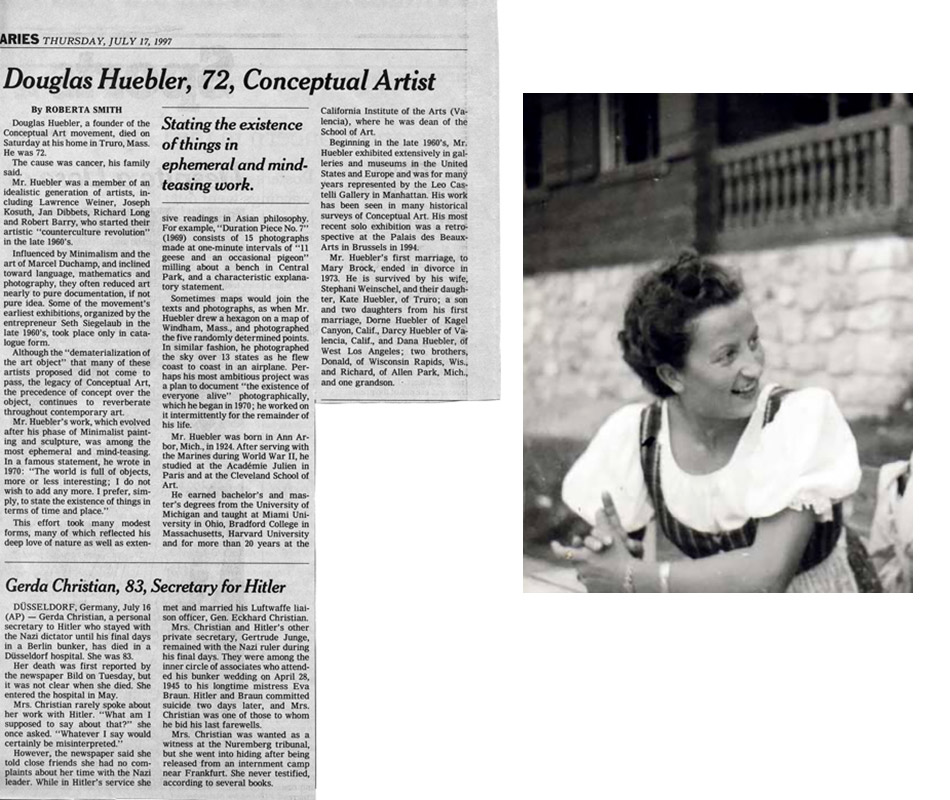
An Ode to Douglas Huebler, 2012
On Thursday, 17 July 1997, Douglas Huebler’s obituary appeared in the New York Times. Discretely beneath him on the same page was the obituary of Gerda Christian. Gerda Christian, along with Traudl Junge, were secretaries to Adolf Hitler. They were witnesses to Hitler’s wedding to Eva Braun and they remained in his bunker until after the joint suicides of Adolf Hitler and Eva Braun on April 30th, 1945. Douglas Huebler is remembered by Roberta Smith in his obituary as a member of “an idealistic generation of artists” who started their artistic “counterculture revolution” in the late 1960s. One of Douglas Huebler’s ambitions was to document “the existence of everyone alive” photographically. The obituary states that he worked on this project begun in the 1970s “intermittently for the remainder of his life.” So of course, my first thought was — And did he photograph her? Gerda Christian? The elusive secretary who manages to hide from the Nuremberg tribunal, even though she has been called as a witness?
I spent two years as a graduate student at California Institute of the Arts. Plenty of time in which to be photographed by Doug if he were indeed documenting us all. He was a member of the art faculty and I saw him often. But to my knowledge, unless of course it was done surreptitiously, I was never photographed by him. So if he missed Gerda Christian, she wasn’t the only one he missed. Perhaps in the tradition of conceptual art of the period, men took priority, and if he didn’t get to the women in time, well that’s just the way it went. I don’t know, I have never seen an archive of his images.
Traudl Junge, Hitler’s youngest personal secretary, outlived Douglas Huebler and Gerda Christian by five years. She died on the 10th of February in 2001 at the age of 81. Did Doug photograph her? Unlike Gerda Christian, Traudl Junge left behind a memoir and a feature length documentary interview filmed just shortly before her death. My favorite moment in the interview is when she says, speaking of Hitler: “Another thing, he would never have flowers in his room. He hated to have dead things around. And that’s strange, when you think about it. Someone who kills thousands of people doesn’t want dead flowers in his room, beautiful flowers.” I liked both the quote and the use of the word “thousands.”
I have spent a lot of time photographing myself, so I have more than made up for my omission in the archive of Douglas Huebler. And luckily for us, both Traudl Junge and the more elusive Gerda Christian were photographed by someone. Perhaps the best thing about Doug’s project was that despite the illusion of closure created by our own finitude, his work acknowledged that everything remains unfinished. There is a rigid totalizing in beliefs like the Rapture. At the end of Lars von Trier’s film Melancholia we can see the appeal of the End of Days scenario. Even if we understand that we all must die, there is a perverse satisfaction in knowing that no one will outlive us. Perhaps the beauty of Doug’s project was the generosity of its predestined failure. He was fine knowing that we would go on without him; that we would be here to read his obituary in the New York Times.